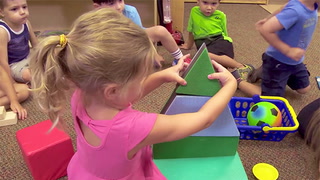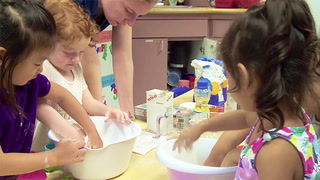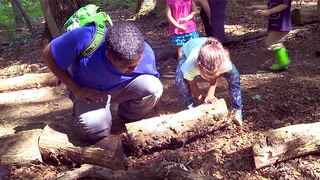Asking Open-Ended Questions Transcript
Narrator: One of the most important ways we can nurture the development of young children's critical thinking and problem solving skills is to use open-ended rather than yes or no questions to encourage conversation.
Teacher 1: Who is this?
Students: Walter the Baker.
Teacher 1: Walter the Baker. That's right. And what does Walter the baker do?
Students: He bakes things!
Teacher 1: He bakes things. What kinds of things?
Students: Pretzels!
Narrator: When children are encouraged to share their ideas and explain their thinking, they are learning to consider, predict, problem solve, and evaluate their own assumptions as well as build their own language skills.
Teacher 1: That would be awesome if he did.
Students: And bake!
Teacher 1: And bake? Yeah, that's right. Those are all things that we use to bake.
Now, Walter the Baker was known even outside the walls of the town. He was the best baker in the whole kingdom. Early every morning, while everyone else was asleep, Walter would bake his breads, rolls, cookies, tarts, and pies.
Students: Don't you love bread?
Teacher 2: When you read a book to children, "Walter the Baker," and you then do an activity related to the book, like making pretzels, once the children are engaged in the activity, not only are they exploring and engage in a science experience you're introducing, they're going to go back and recall the story and they're going to be using the words and like, "Oh, Walter did this, and when he rolled it out and he did this, he made two holes or three holes." So children are also recalling the story and so you're bringing literature into your STEM experiences.
Teacher 1: Patty-cake, patty-cake, baker's men, bake me a cake as fast as you can. You roll it, pat it, mark it with a B.
Today we did an activity of baking where we made pretzels. My friends used measurements and we discussed the different sensations that they could smell, touch, feel, and we introduced that concept through the book, "Walter the Baker."
I would like you to take your hands and gently mix all that together. Gently. Here we go. We're going to use our gentle hands. What does that feel like, my friends?
Students: Flowers.
Or soft.
Teacher 1: It feels soft? Do you think so?
What does it feel like, do you know?
Students: Feels softy.
Teacher 1: What do you feel? What do you smell? What do you think will happen when the salt is mixed with the flour? Those things are science and they're using their observation skills to describe and use their words to tell you what they see and what they feel.
Teacher 2: A skilled educator will know when to approach a child and when to stand back. If a child is totally focused on the activity, you don't want to come in and ask them, "Oh, well, what are you doing? And how is that going to work?" because you're going to break their concentration. You rather allow the child to complete what they're doing and then ask you're open-ended question. If a child is looking around and engaging with other children, that's the time that you can come in and ask a question.
Teacher 1: So what shapes are you guys going to try to do? I heard some interesting suggestions.
Students: Snake!
Teacher 1: A snake? What else can we do?
Students: We could twist it.
Teacher 1: You can twist it! You're right. You're right.
Students: And we can make a pancake out of it.
Teacher 2: Open-ended questions are really important in STEM exploration because we want children to learn the basic scientific method: Observation, prediction, being able to express and communicate what they have found. So open-ended questions allow them to think critically and to analyze what they're saying and the information that they have come across.
Teacher 1: What does it taste like? What does it taste like, guys?
Here. That's for you. What does it taste like?
What does it taste like?
Students: Pretzels.
Teacher 1: Pretzels?














6 Comments
Scarlette Moore Apr 20, 2022 7:21pm
When teachers use open-ended questions, children are able to use their thinking skills. They are able to express themselves more. Children enjoy being a part of the learning process.
Yvonne Norfleet Apr 20, 2022 5:02pm
Open-ended questions help children to use their critical thinking skills as they observe and predict what might happen next.
Charlotte Humphrey Aug 16, 2021 7:28pm
Enjoyed the common sense way to engage the students. It's always helpful!
Thank you,
Diane Nelson Feb 13, 2019 9:33am
Open-ended questions encourage students to think beyond the literal answer and explore alternatives responses. Open-ended questions encourage creativity in children.
jennifer neff Jan 29, 2018 11:48am